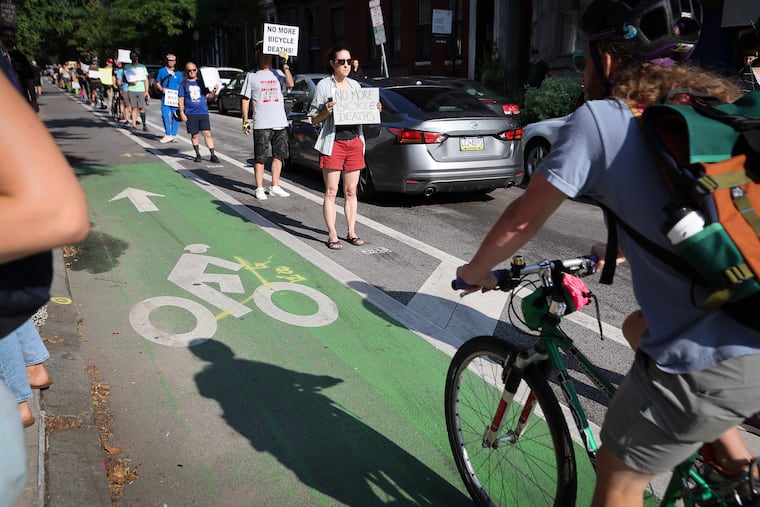Concrete barriers are not the only way to protect cyclists in Spruce and Pine bike lanes
We must reduce vehicular speed by using speed cushions, raised pedestrian crosswalks, and delineator posts.

The deaths of bicyclists Barbara Friedes and Emily Fredricks were horrific and spurred a new city law prohibiting stopping in bike lanes. However, according to published reports, Friedes was struck by a motorist going over 50 mph with a blood-alcohol concentration that was twice the legal limit, while Fredricks was struck by a truck that turned into her in an intersection. Neither the new city law nor the contemplated curb separators would have spared either of them.
The Center City Residents’ Association’s proposed alternative to making the Spruce and Pine bike lanes safer might have spared both of them. Our plan consists of three elements:
Place one speed cushion and one raised pedestrian crosswalk on every block between Broad and 22nd Streets
Speed kills. Although the speed limit on Spruce and Pine Streets is 25 mph and there are synchronized traffic lights, vehicles are often traveling at speeds far in excess of the limit. Speed cushions and raised pedestrian crosswalks are physical features that are proven to reduce traffic speeds.
And the raised pedestrian crosswalk, placed across the beginning of each block (on the western portion of the intersections on Spruce and the eastern portion of the intersections on Pine) will make pedestrians more visible — and announce to drivers that these blocks are “different” and they need to pay special attention.
Permit temporary stopping in bike lanes, but reduce the maximum time limit
Currently, the limit for a temporary stop is 20 minutes. We propose reducing that time to 10 minutes and limiting the availability of such temporary stopping to passenger vehicles (private cars, ride-share, taxis). Doing so will eliminate use by, among others, delivery vehicles and contractor vans which, in and of itself, will substantially reduce the number of vehicles that presently stop in the bike lanes.
The time reduction should accommodate the loadings and unloadings residents are concerned about, while also making enforcement easier, encouraging use of the many already existing daytime loading zones, and likely reducing the number of interactions with cyclists using the bike lanes.
Use white plastic delineator posts
To separate the traffic lane from the bike lane, use white plastic delineator posts, generally spaced 30 feet apart, but with the last three on each block on which a left turn can be made spaced just 10 feet apart.
Delineator posts would provide further identification of the bike lanes (beyond the painted buffers that exist presently) and also serve as a deterrent to drivers who might be tempted to enter the bike lanes (especially drivers seeking to make a left turn across the bike lane). In addition, the mere presence of such posts tends to reduce traffic speeds, much in the way narrower traffic lanes do.
Setting them 30 feet apart would enable passenger vehicles seeking to temporarily stop in the bike lane to do so, although approaching at a slower speed than if the posts did not exist. That distance would also enable vehicles to slowly enter the bike lane if they needed to do so to get around a vehicle that is temporarily stopped in the traffic lane for a quick drop-off or pickup.
CCRA has long-supported bike lanes, and we have regular users of bike lanes among our members and our board. Everyone wants bike lanes to be safe.
However, the Spruce and Pine bike lanes are different from other bike lanes in Philadelphia. Aside from the fact that they exist on a narrow street with but one lane of traffic, they were the product of a 2009 compromise: elimination of the curbside traffic lane for conversion to a bike lane in exchange for a continuation of the historic practice of permitting temporary 20-minute stopping in the bike lane.
In the absence of this compromise, it is quite possible the bike lanes never would have been created on Spruce or Pine. CCRA’s proposal reflects an attempt to acknowledge this historical background while limiting the temporary stopping to passenger vehicles and reducing the duration to 10 minutes.
Equally important, we must reduce vehicular speed by using speed cushions, raised pedestrian crosswalks, and delineator posts.
Leo Levinson is president of the Center City Residents’ Association, a registered community organization (RCO) of volunteers representing the residents who live in the western neighborhoods of Center City, from Broad Street to the Schuylkill and from South Street to JFK Boulevard.